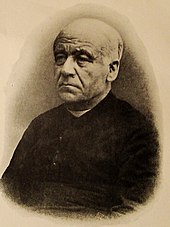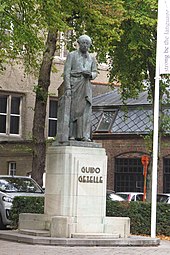Guido Gezelle
Guido Pieter Theodorus Josephus Gezelle (born May 1, 1830 in Bruges ; † November 27, 1899 there ) is considered the most important Flemish poet of the 19th century .
Life
Guido Gezelle was born to Monica Devrieze and Pieter Jan Gezelle. He was born with a head that was larger than average and was therefore emergency baptized immediately after birth and the baptism ceremony held later. Because his parents lacked money, Guido could not go to secondary school in Bruges. His parents then sent him to Roeselare , where he received a theological training. He was ordained a Roman Catholic priest in 1854 . He held the post of teacher, where he was particularly committed to preserving the Dutch language . That made him unpopular with many colleagues. Guido Gezelle lived in Kortrijk for many years and wrote poems there that he was able to publish.
Guido Gezelle died at the age of 69. The grave is on the Centrale Begraafplaats in his hometown. In addition, a memorial was erected in the place.
plant
He was hardly influenced by the literary currents of his time. His work Kerkhofblommen ( Friedhofsblumen, 1858) became the starting point for the rebirth of Flemish poetry. Gezelle's poems combined the traditional Dutch literary language with his own West Flemish dialect in a unique way . He was soon regarded as one of the most important Flemish poets of the 19th century.
Popular subjects of his poems are observations of nature and religious feelings, often both are combined. Formally, his poems differ in their increasing poetic freedom. Gezelle experimented with new verse and stanza forms , neologisms , repetitions and onomatopoeia . Some of his poems show kinship with literary impressionism .
Gezelle's poetic struggles with nationalism led to conflicts with representatives of the church and the school system. Therefore, between 1870 and 1875, he limited his work to essays and translations . Later works such as Tijdkrans ( Zeitkranz , 1893) and Rijmsnoer ( Reim-Band , 1897) tied in with the linguistic art of his first creative phase.
- overview
- Vlaemsche Dichtoefeningen (1858)
- Kerkhofblommen (1858)
- Poems, plucked and given (1862)
- Tijdkrans (1893)
- Rijmsnoer om en om het jaar (1897)
- Laatste verzen (published only after death; 1901)
Web links
- Guido Gezelle - Biographical data in the Online Database Voor Intermediaire Structuren (ODIS)
- Literature by and about Guido Gezelle in the catalog of the German National Library
Individual evidence
- ↑ knerger.de: The grave of Guido Gezelle
| personal data | |
|---|---|
| SURNAME | Gezelle, Guido |
| ALTERNATIVE NAMES | Gezelle, Guido Pieter Theodorus Josephus (full name) |
| BRIEF DESCRIPTION | Flemish poet |
| DATE OF BIRTH | May 1, 1830 |
| PLACE OF BIRTH | Bruges |
| DATE OF DEATH | November 27, 1899 |
| Place of death | Bruges |


